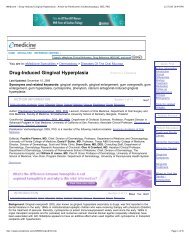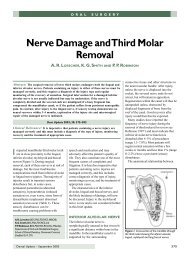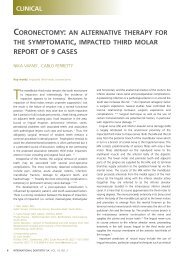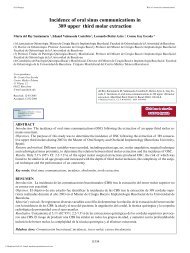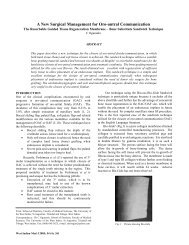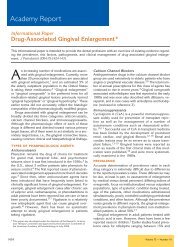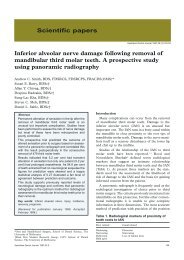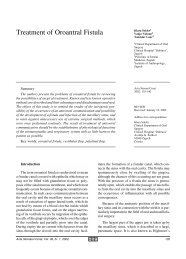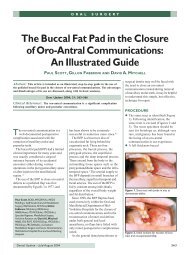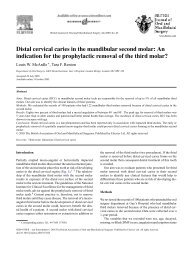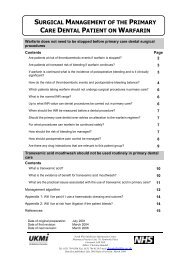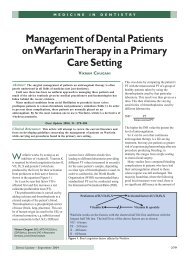Oro-Antral Communications: - Exodonti.info
Oro-Antral Communications: - Exodonti.info
Oro-Antral Communications: - Exodonti.info
- No tags were found...
Create successful ePaper yourself
Turn your PDF publications into a flip-book with our unique Google optimized e-Paper software.
<strong>Oro</strong>-<strong>Antral</strong><strong>Communications</strong>Ætiology, Diagnosis, Avoidance & RepairJohn Doran, Associate Specialist Oral Surgeon,Queen Victoria Hospital, East Grinstead
<strong>Oro</strong>-<strong>Antral</strong> <strong>Communications</strong>What is an <strong>Oro</strong>-<strong>Antral</strong> Communication?Communication between the maxillary sinus and the oralcavity.What is an <strong>Oro</strong>-<strong>Antral</strong> Fistula?If an OAC is not treated, this can become lined withepithelium. Hence, an oro-antral fistula is an epithelisedtract linking the maxillary sinus to the oral cavity.(Synonyms also include oro-antral & oral fistulæ, sinusperforations and antra-oral fistulæ)
<strong>Oro</strong>-<strong>Antral</strong> <strong>Communications</strong>
<strong>Oro</strong>-<strong>Antral</strong> <strong>Communications</strong>Why is an OAC a problem (1)?When an OAC is created, this allows the flow offood, smoke or fluid from the mouth, via themaxillary sinus and into the nose.Not just these but also bacteria, fungi andviruses. This can set up a maxillary sinusitis,which depending on how long the communicationlasts for, may either yield an acute/chronicmaxillary sinusitis.
<strong>Oro</strong>-<strong>Antral</strong> <strong>Communications</strong>
<strong>Oro</strong>-<strong>Antral</strong> <strong>Communications</strong>Why is an OAC a problem (2)?• Patients aren‟t impressed.• Not a practice builder.• Possible hospitalisation.• Possibly medico-legal action.• Removes bone that may be needed for implants (sinusrepair & „lift‟/augmentation may be needed).• Remove bony support for dentures (e.g. tuberosityfracture associated with OAC).
<strong>Oro</strong>-<strong>Antral</strong> <strong>Communications</strong>Maxillary Sinusitis (1):Sinusitis pain may occur in the cheek, around theeye or in the forehead.Sometimes the pain may be felt in the upper teethand mistaken for toothache.Feel malaised, with a headache and perhaps astuffy nose.Discharge of pus into the nose is not noticed untilbeginning to recover.
<strong>Oro</strong>-<strong>Antral</strong> <strong>Communications</strong>Maxillary Sinusitis (2):Swelling of the face over the sinus sometimesoccurs but is not usually marked.Some patients have repeated infections and go onto develop chronic sinusitis.Nasal discharge from the back of the nose downthe throat may occur.Often the condition will flare up, with acute pain.
<strong>Oro</strong>-<strong>Antral</strong> <strong>Communications</strong>Ætiology of OAC’s (1):• The underlying factors were exodontia (48%),tumours (18.5%), osteomyelitis (11%), Caldwell-Luc procedures (7.5%), trauma (7.5%),dentigerous cysts (3.7%), and correction ofseptal perforations (3.7%).• Tooth extraction was the most commonætiological factor; malignancy should beexcluded in all patients.
<strong>Oro</strong>-<strong>Antral</strong> <strong>Communications</strong>
<strong>Oro</strong>-<strong>Antral</strong> <strong>Communications</strong>Ætiology of OAC’s (2):• Perforation occurred in 77 of all 2,038 teeth (3.8%). Ofthese, 38 teeth were from males (38/733; 5.2%), and 39were from females (39/1,305; 3.0%) .• The perforation rate was significantly higher in males.• Perforation occurred most often with extraction of anupper 1 st molar, and in the third decade of life.• The perforation rate gradually decreased with higherage.Details from the 1 st Department of Oral and Maxillofacial Surgery,Tokyo Medical and Dental University 1991 - 1993.
<strong>Oro</strong>-<strong>Antral</strong> <strong>Communications</strong>
<strong>Oro</strong>-<strong>Antral</strong> <strong>Communications</strong>Ætiology of OAC’s (3):OAC’s occur with a variety of dental surgicalprocedures/pathologies:• Apicectomies of maxillary premolars & molars(perforations occurred in 10.4% of teeth ).• Plunging an elevator through the bony floor during roottip removal.• Forcing root tips or tooth into sinus.• Penetration while exposing impacted teeth.• Perforation during incorrect curettage.• Fracture of segment of the alveolar process containingseveral teeth with tearing of floor of antrum.
<strong>Oro</strong>-<strong>Antral</strong> <strong>Communications</strong>
<strong>Oro</strong>-<strong>Antral</strong> <strong>Communications</strong>Ætiology of OAC’s (4):• Luxating an impacted 3 rd molar into the antrum whilstattempting to remove it.• HIV-associated periodontitis complicated by necrotisingstomatitis and the development of an oro-antral fistula.• Enucleating dental maxillary cysts where the partitiontwixt cyst and antral lining has become blurred.• Destruction of the maxillary floor by chronic apicalinfection.
<strong>Oro</strong>-<strong>Antral</strong> <strong>Communications</strong>How Do You Pre-Empt Potential OACSituations?• As always, you have to carefully assess the patient - Youcannot be gung-ho or complacent about it.• You should not consider removing the tooth if you or yourstaff do not have the expertise / competence / equipmentto resolve any untoward events that may develop.• Refer the patient to Specialists or to the Oral SurgeryDepartment if in doubt.
<strong>Oro</strong>-<strong>Antral</strong> <strong>Communications</strong>Pre-op Assessment of the Patient (1):• Does the tooth need to come out?• Medical History & Dental History checked.• What does it look like on the X-ray?
<strong>Oro</strong>-<strong>Antral</strong> <strong>Communications</strong>Pre-op Assessment of the Patient (2):Medical History• Underlying systemic disease e.g.: cardiovascular/ metabolic / endocrine / hæmatological.• Presence / absence of associated disease (e.g.:cysts/ neoplasia).• Presence / absence of other local bone / softtissue disease (e.g.: Paget's Disease / vascularmalformations / osteoradionecrosis).
<strong>Oro</strong>-<strong>Antral</strong> <strong>Communications</strong>Pre-op Assessment of the Patient (3):Dental History & What does it look like on the X-ray?• Previous history of OAC‟s.• Bone quantity / quality / density (infective / condensingosteitis; isolated tooth due to extraction of adjacentteeth some years previously; bridge abutments; PagetsDisease; Osteopetrosis).• Anatomical position (e.g.: angulation / rotation leadingto limited visual access).• Previous radiotherapy.• Extent / Proximity of Antrum.
<strong>Oro</strong>-<strong>Antral</strong> <strong>Communications</strong>Pre-op Assessment of the Patient (4):• Associated ankylosis / hypercementosis.• Root morphology (divergent roots / curved roots).• Status of adjacent teeth (e.g.: periodontal disease /presence of restoration / function as bridge abutment).• RCT?• Periapical infections / Periodontal disease.• Relationship to the tuberosity.• Lone standing tooth or adjacent teeth?• Patient cooperation / compliance.• Age of patient.
<strong>Oro</strong>-<strong>Antral</strong> <strong>Communications</strong>As a very broad generalisation, the following maybe thought to indicate an OAC-likely situation:• Proximity of Antrum.• Hypercementosis / Ankylosis.• Periapical infections / Long-standing Caries.• Marked Periodontitis.• Proximity to the Tuberosity.• Lone-standing / End of Arch.• Previous history of OAC‟s.
<strong>Oro</strong>-<strong>Antral</strong> <strong>Communications</strong>What To Do Surgically?• Warn the patient as to what to expect of the procedure &take their consent.• (Use a periotome?)• Raise a flap that can be converted into a buccal flap toclose the OAC.• Remove bone from around the tooth in question.• Section the tooth.• Elevate with care.• Check the socket after exodontia.• If no OAF obvious, close as normal.• Post-op advice including no nose-blowing, advice aboutsigns / symptoms of an OAC.
<strong>Oro</strong>-<strong>Antral</strong> <strong>Communications</strong>How to Recognise the Acute OACIf OAC possible, then:• Examine tooth for adherent bone.• “Nose-blowing” test.• Determine the size of the defect.• < 2mm in diameter, no treatment required.NB The majority of OAC‟s are not diagnosed as theyspontaneously heal.
<strong>Oro</strong>-<strong>Antral</strong> <strong>Communications</strong>Treatment of the Acute OAF:• Do not probe the defect• Promote good blood clot• Good gingival approximation• Hæmostatic Agent (Surgicel, Curaspon)• Antibiotics (Amoxycillin, Vibramycin)• Nasal decongestants (Ephedrine nasal drops,Oxymetazoline)• Steam inhalations (Menthol & Eucalyptus)• Antiseptic mouth-wash (Corsodyl)• No nose-blowing or smoking
<strong>Oro</strong>-<strong>Antral</strong> <strong>Communications</strong>How to Recognise the Chronic OAC / OAF (1):The OAC is likely to become chronic / OAF if:• OAC is greater than 5mm in diameter• Gingival tissues can‟t be approximated• Post-op régime is not followed• Wound dehiscence• Enucleation of a cyst
<strong>Oro</strong>-<strong>Antral</strong> <strong>Communications</strong>How to Recognise the Chronic OAC / OAF (2):• May develop 4 – 6 weeks post-extraction.• Problems with smoking, eating or drinking.• Cacogeusia.• Chronic maxillary sinusitis.• <strong>Antral</strong> polyp herniating into oral cavity.• Purulent discharge from nose.
<strong>Oro</strong>-<strong>Antral</strong> <strong>Communications</strong>Treatment of the Chronic/Larger OAC / OAF (1):• Assess the OAC / OAF radiographically by OM‟s,OPG‟s, PA‟s or CT‟s.• May still spontaneously close if cover plate used.• If OAC / OAF needs closing, pre-op antibiotic &decongestant régime (starting 3 – 7 days pre-op).
<strong>Oro</strong>-<strong>Antral</strong> <strong>Communications</strong>Treatment of the Chronic/Larger OAC / OAF (2):Buccal Flaps• Buccal Advancement Flap most common.• Described by Rehrmann & made popular by Berger.
<strong>Oro</strong>-<strong>Antral</strong> <strong>Communications</strong>
<strong>Oro</strong>-<strong>Antral</strong> <strong>Communications</strong>Treatment of the Chronic/Larger OAC / OAF (3):Buccal Advancement Flap• Broad base providing good blood supply.• Periosteum scored parallel to base of flap to allowgreater mobilisation of flap.• OAC / OAF mucosa excised.• Alveolus reduced in height.• Palatal mucosa incised & mobilised.• Flap brought across defect & secured with sutures.• There must be no / minimal tension on the flap.• Disadvantage of reduction of buccal vestibular depth;reshapes in 4 - 8 weeks as flap adapts to underlying bone.
<strong>Oro</strong>-<strong>Antral</strong> <strong>Communications</strong>
<strong>Oro</strong>-<strong>Antral</strong> <strong>Communications</strong>Treatment of the Chronic/Larger OAC / OAF (3):Palatal Flaps• Palatal Rotational Advancement Flap most common.• Others include Palatal Pedicle Island Flap (Henderson),V-shaped Palatal Flap (Krueger) & Split-thicknessPalatal Flap (Ito & Hara).
<strong>Oro</strong>-<strong>Antral</strong> <strong>Communications</strong>
<strong>Oro</strong>-<strong>Antral</strong> <strong>Communications</strong>Treatment of the Chronic/Larger OAC / OAF (4):Palatal Rotational Advancement Flap• Advantages of insured vascularity (greater palatinevessels) & thickness of tissue more like crest of ridge.• OAC / OAF mucosa excised.• Buccal mucosa incised & mobilised.• Flap brought across defect & secured with sutures.• There must be no / minimal tension on the flap.• Allows for the maintenance of the vestibular sulcus depth.• Indicated in cases of unsuccessful buccal flap closure.• Disadvantage of raw surface left behind; can be coveredwith a plate or Coe-pack.
<strong>Oro</strong>-<strong>Antral</strong> <strong>Communications</strong>Treatment of the Chronic/Larger OAC / OAF (5):Post-op Régime:• Antibiotics (Amoxycillin, Vibramicin)• Analgesics• Nasal decongestants (Ephedrine nasal drops,Oxymetazoline)• Steam inhalations (Menthol & Eucalyptus)• Antiseptic mouth-wash (Corsodyl)• No nose-blowing or smoking
<strong>Oro</strong>-<strong>Antral</strong> <strong>Communications</strong>Alternative Ways to Close an OAC:• Buccal fat pad.• Laser bio-stimulation (over 5 days).• Transplantation of a mature third molar(followed by RCT of the tooth 5-6 weeks later).• Autogenous monocortical bone blocks (from thechin)
<strong>Oro</strong>-<strong>Antral</strong> <strong>Communications</strong>Buccal fat pad closure of OAC• 55 year old male.• <strong>Exodonti</strong>a of UR7 created OAC.• Complaining of stuffy R maxillary sinus,discharge from the sinus & fluid from noseafter drinking.
<strong>Oro</strong>-<strong>Antral</strong> <strong>Communications</strong>
<strong>Oro</strong>-<strong>Antral</strong> <strong>Communications</strong>
<strong>Oro</strong>-<strong>Antral</strong> <strong>Communications</strong>
<strong>Oro</strong>-<strong>Antral</strong> <strong>Communications</strong>
<strong>Oro</strong>-<strong>Antral</strong> <strong>Communications</strong>
<strong>Oro</strong>-<strong>Antral</strong> <strong>Communications</strong>
<strong>Oro</strong>-<strong>Antral</strong> <strong>Communications</strong>
<strong>Oro</strong>-<strong>Antral</strong> <strong>Communications</strong> (UL8)
<strong>Oro</strong>-<strong>Antral</strong> <strong>Communications</strong> (UL8)
<strong>Oro</strong>-<strong>Antral</strong> <strong>Communications</strong> (UL8)
<strong>Oro</strong>-<strong>Antral</strong> <strong>Communications</strong> (UR5)
<strong>Oro</strong>-<strong>Antral</strong> <strong>Communications</strong> (UR5)
<strong>Oro</strong>-<strong>Antral</strong> <strong>Communications</strong> (UL7)
<strong>Oro</strong>-<strong>Antral</strong> <strong>Communications</strong> (UL7)
<strong>Oro</strong>-<strong>Antral</strong> <strong>Communications</strong> (UL8)
<strong>Oro</strong>-<strong>Antral</strong> <strong>Communications</strong> (UL8)
<strong>Oro</strong>-<strong>Antral</strong> <strong>Communications</strong> (UL8)
<strong>Oro</strong>-<strong>Antral</strong> <strong>Communications</strong>Thank you for your attention.If you do encounter an OAC / OAF, I hopethis talk will help you in how you decide totreat it.



